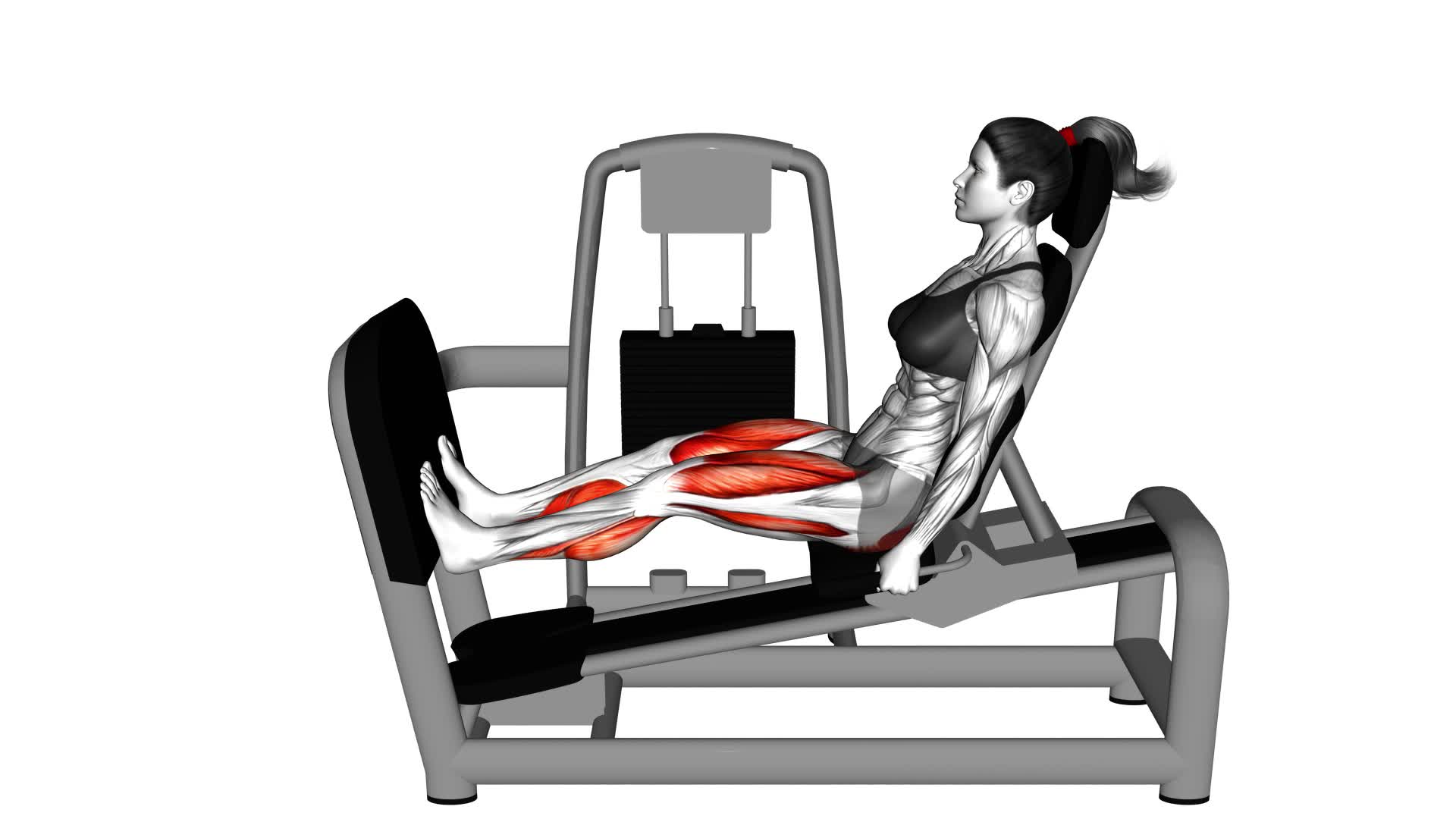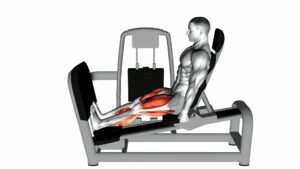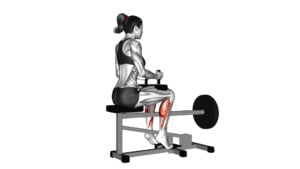Lever Seated Squat Calf Raise on Leg Press Machine (female) – Video Exercise Guide & Tips

Are you looking for an effective way to target and strengthen your calf muscles? Look no further than the lever seated squat calf raise on the leg press machine.
Watch This Exercise Video
In this video exercise guide, we'll show you the proper setup, correct foot placement, and step-by-step technique to perform this exercise.
We'll also share common mistakes to avoid, tips for increasing intensity, and alternative variations to challenge your calves.
Get ready to feel the burn and see results with this powerful calf exercise.
Key Takeaways
- Proper setup and technique are crucial for the Lever Seated Squat Calf Raise on the Leg Press Machine.
- Correct foot placement and body alignment are essential to avoid injuries and maximize muscle activation.
- Increasing intensity and progression can be achieved by incorporating heavier weights, adjusting repetitions, and listening to your body.
- Alternative calf variations such as jump rope calf raises, single leg raises, and step-up calf raises can provide additional benefits and add variety to the workout routine.
Proper Setup on the Leg Press Machine
To properly set up on the leg press machine, position your feet shoulder-width apart on the footplate. This is the first step to ensure a safe and effective workout.
The leg press machine offers numerous benefits for your lower body, including strengthening your quadriceps, hamstrings, and glutes. Additionally, it can help improve your overall lower body strength and power.
Before you start your workout, it's important to adjust the leg press machine according to your body's needs. Begin by adjusting the seat height so that your knees are at a 90-degree angle when your feet are on the footplate. This will ensure proper form and prevent any unnecessary strain on your joints.
Next, adjust the backrest of the machine to a comfortable position that supports your lower back. This will help maintain proper spinal alignment throughout the exercise.
Once you have made these adjustments, ensure that the safety pins are correctly in place to prevent any accidents or injuries during your workout.
Correct Foot Placement for Targeting the Calves
Position your feet properly on the footplate of the leg press machine to effectively target your calves. The correct foot placement is crucial for maximizing calf muscle engagement and reaping the benefits of calf raises.
To begin, sit on the leg press machine with your back against the pad and place your feet shoulder-width apart on the footplate. Make sure that your toes are pointing straight ahead. This position will ensure that the load is evenly distributed across your calves.
As you lower the weight by bending your knees, keep your heels on the footplate and push through your toes to lift the weight back up. This movement will primarily target your calf muscles.
Remember to maintain a controlled and steady pace throughout the exercise to prevent any jerking or bouncing.
Step-By-Step Technique for the Lever Seated Squat Calf Raise
Start by sitting on the leg press machine with your back against the pad and placing your feet shoulder-width apart on the footplate. This is the proper form for the lever seated squat calf raise exercise. Once you're in position, engage your core and keep your back straight throughout the movement.
To perform the exercise, press through your heels and raise your toes as high as possible by extending your ankles. Hold the contraction briefly at the top before slowly lowering your heels back down to the starting position. Remember to maintain control and avoid using momentum to complete the repetitions.
To increase the intensity of the exercise, you can adjust the weight on the leg press machine. Start with a weight that challenges your calf muscles but still allows you to maintain proper form. As you progress, you can gradually increase the weight to continue challenging your calves and promoting muscle growth.
Keep in mind that it's important to listen to your body and avoid any pain or discomfort during the exercise. If you experience any issues, consult with a fitness professional or medical expert.
Common Mistakes to Avoid During the Exercise
To perform the lever seated squat calf raise correctly, it's important to avoid common mistakes that can compromise your form and results.
One common mistake is incorrect foot placement, which can lead to improper targeting of the calf muscles.
Another mistake to avoid is a lack of proper form, such as not keeping your back straight and shoulders relaxed.
Incorrect Foot Placement
Make sure you position your feet correctly to avoid common mistakes during the Lever Seated Squat Calf Raise on the Leg Press Machine. Incorrect foot placement can lead to incorrect form and foot positioning errors, which can diminish the effectiveness of the exercise and potentially cause injury.
To achieve proper foot placement, start by positioning your feet shoulder-width apart on the foot plate. Your toes should be pointing slightly outward. Make sure your feet are flat on the foot plate and avoid lifting your heels during the exercise.
Keep your weight evenly distributed throughout your feet and avoid placing too much pressure on your toes or heels. By ensuring correct foot placement, you can maximize the benefits of the exercise and minimize the risk of injury.
Lack of Proper Form
To ensure proper form and avoid common mistakes during the Lever Seated Squat Calf Raise on the Leg Press Machine, it's crucial that you maintain correct body alignment throughout the exercise.
Improper technique can lead to potential injuries and hinder your progress. One common mistake to avoid is rounding your back or hunching your shoulders. This can put unnecessary strain on your spine and increase the risk of back pain or injury.
Additionally, be mindful of your knee alignment. Make sure your knees are tracking in line with your toes and avoid allowing them to collapse inward. This can cause stress on the knee joint and potentially lead to knee pain or injury.
Tips for Increasing Intensity and Progression
To increase intensity and progression, aim to incorporate at least three sets of 10-12 repetitions with heavier weights into your Lever Seated Squat Calf Raise on the Leg Press Machine routine. Increasing the resistance by adding more weight will challenge your calf muscles even more and help you build strength and definition. Start with a weight that allows you to complete the desired number of repetitions with proper form, but still feels challenging. As you progress, gradually increase the weight to continue challenging your muscles.
Another way to increase the intensity of your calf raises is by incorporating tempo variations. Instead of performing the exercise at a regular speed, try slowing down the lowering phase, also known as the eccentric phase. This will increase the time under tension for your calf muscles, making the exercise more challenging and effective. Aim for a slow and controlled lowering phase, taking about 2-3 seconds to lower your heels back to the starting position. This will engage your calf muscles for a longer period, leading to greater muscle activation and growth.
Remember to always listen to your body and adjust the intensity and progression of your workout routine accordingly. It's important to challenge yourself but also to avoid overexertion or injury. By incorporating heavier weights and tempo variations into your Lever Seated Squat Calf Raise on the Leg Press Machine routine, you can effectively increase the intensity and progression of your calf workout.
Alternative Variations to Challenge Your Calf Muscles
Looking to challenge your calf muscles even further? Try incorporating these alternative variations into your calf workout routine.
First, try jump rope calf raises, where you jump rope while raising and lowering your heels.
Next, give single leg raises a go by standing on one leg and raising and lowering your heel.
Finally, step-up calf raises can be done by placing the ball of your foot on a step or elevated surface and raising and lowering your heel.
Give these variations a try for an extra calf burn!
Jump Rope Calf Raises
Challenge your calf muscles with alternative variations of jump rope calf raises. Jump rope isn't only a fun and effective cardio exercise, but it also offers numerous benefits for your calf muscles. When performing jump rope calf raises, focus on using proper technique to maximize the benefits.
Start by standing with your feet shoulder-width apart and holding the jump rope handles. Begin jumping, and as you do, rise up onto the balls of your feet, engaging your calf muscles. Land softly and repeat the motion, aiming for a smooth and controlled movement.
You can also try variations such as single-leg jump rope calf raises or adding ankle weights for an extra challenge. Remember to always listen to your body and start with a comfortable pace before increasing intensity.
Single Leg Raises
If you enjoyed the jump rope calf raises, you can continue challenging your calf muscles with alternative variations such as single leg raises. Single leg raises are a great way to target your calf muscles and improve their strength and definition.
Here are four variations of single leg raises that you can try:
- Standing Single Leg Raises: Stand with one foot on a step or elevated surface. Slowly raise your heel as high as possible, then lower it back down. Repeat on the other leg.
- Seated Single Leg Raises: Sit on a chair or bench with one foot flat on the ground and the other leg extended in front of you. Raise your extended leg by flexing your calf muscle and hold for a second before lowering it back down.
- Wall Single Leg Raises: Stand facing a wall and place your hands on it for balance. Lift one foot off the ground and raise your heel as high as possible. Lower it back down and repeat on the other leg.
- Single Leg Calf Raises on a Machine: Use a calf raise machine or a resistance band to perform single leg raises. Follow the proper form to ensure maximum effectiveness and prevent injury.
Incorporating these single leg raises into your calf workout routine can help you build stronger and more defined calf muscles. Remember to maintain proper form and gradually increase the intensity and repetitions for optimal benefits.
Step-Up Calf Raises
To challenge your calf muscles, try incorporating step-up calf raises into your workout routine. Step-up calf raises are a great way to target and strengthen your calf muscles while also improving balance and stability.
There are several variations of step-up calf raises that you can try to add variety and increase the intensity of your workout. One variation is the weighted step-up calf raise, where you hold dumbbells or a barbell while performing the exercise. Another variation is the single-leg step-up calf raise, where you focus on one leg at a time to really isolate and engage the calf muscles.
The benefits of step-up calf raises include increased calf strength, improved ankle stability, and enhanced athletic performance. So, give step-up calf raises a try and feel the burn in your calves!
Frequently Asked Questions
How Many Sets and Repetitions Should I Do for the Lever Seated Squat Calf Raise on the Leg Press Machine?
For the lever seated squat calf raise on the leg press machine, you should aim for 3 to 4 sets with 12 to 15 repetitions per set. This will help target and strengthen your calf muscles effectively.
If you're a beginner, it's okay to start with lighter weights and fewer repetitions, gradually increasing as you get more comfortable.
Remember to always listen to your body and adjust the sets and repetitions based on your fitness level and goals.
Can I Do This Exercise if I Have a Previous Calf Injury?
Yes, if you have a previous calf injury, it's important to take precautions when doing the Lever Seated Squat Calf Raise on the Leg Press Machine.
Start by consulting with a healthcare professional to determine if this exercise is suitable for your condition. If not, they can suggest alternative exercises for calf injury recovery.
Always listen to your body and avoid any movements that cause pain or discomfort.
Prioritize your safety and healing throughout your fitness journey.
Is It Important to Warm up Before Performing the Lever Seated Squat Calf Raise on the Leg Press Machine?
It is important to warm up before performing the lever seated squat calf raise on the leg press machine. Warming up helps increase blood flow to your muscles, preparing them for the exercise and reducing the risk of injury.
Additionally, warming up can improve your range of motion and enhance your overall performance.
There are variations of the lever seated squat calf raise that you can explore to challenge your muscles in different ways and avoid plateauing in your fitness journey.
What Muscles Other Than the Calves Are Targeted During This Exercise?
During the lever seated squat calf raise on the leg press machine, besides targeting the calves, other muscles are also engaged. This exercise activates the quadriceps, hamstrings, and glutes, helping to strengthen and tone your lower body.
Additionally, it improves balance and stability by targeting the muscles responsible for maintaining proper posture and control during the movement.
Incorporating this exercise into your workout routine can have numerous benefits for your overall lower body strength and stability.
Can I Use This Exercise to Improve My Balance and Stability?
Yes, you can definitely use this exercise to improve your balance and stability. By engaging your calf muscles and core, this exercise helps to strengthen the muscles that are essential for maintaining balance.
The lever seated squat calf raise on the leg press machine challenges your stability as you perform the movement. Focus on maintaining proper form and control throughout the exercise to maximize the benefits for your balance and stability.
Conclusion
Incorporating the lever seated squat calf raise on the leg press machine into your workout routine is a great way to target and strengthen your calf muscles.
By following the proper setup and technique, avoiding common mistakes, and implementing tips for increasing intensity, you can effectively challenge your calves and make progress.
Remember to always listen to your body and adjust the exercise as needed to ensure safety and effectiveness.

Author
Years ago, the spark of my life’s passion ignited in my mind the moment I stepped into the local gym for the first time. The inaugural bead of perspiration, the initial endeavor, the very first surge of endorphins, and a sense of pride that washed over me post-workout marked the beginning of my deep-seated interest in strength sports, fitness, and sports nutrition. This very curiosity blossomed rapidly into a profound fascination, propelling me to earn a Master’s degree in Physical Education from the Academy of Physical Education in Krakow, followed by a Sports Manager diploma from the Jagiellonian University. My journey of growth led me to gain more specialized qualifications, such as being a certified personal trainer with a focus on sports dietetics, a lifeguard, and an instructor for wellness and corrective gymnastics. Theoretical knowledge paired seamlessly with practical experience, reinforcing my belief that the transformation of individuals under my guidance was also a reflection of my personal growth. This belief holds true even today. Each day, I strive to push the boundaries and explore new realms. These realms gently elevate me to greater heights. The unique combination of passion for my field and the continuous quest for growth fuels my drive to break new ground.



